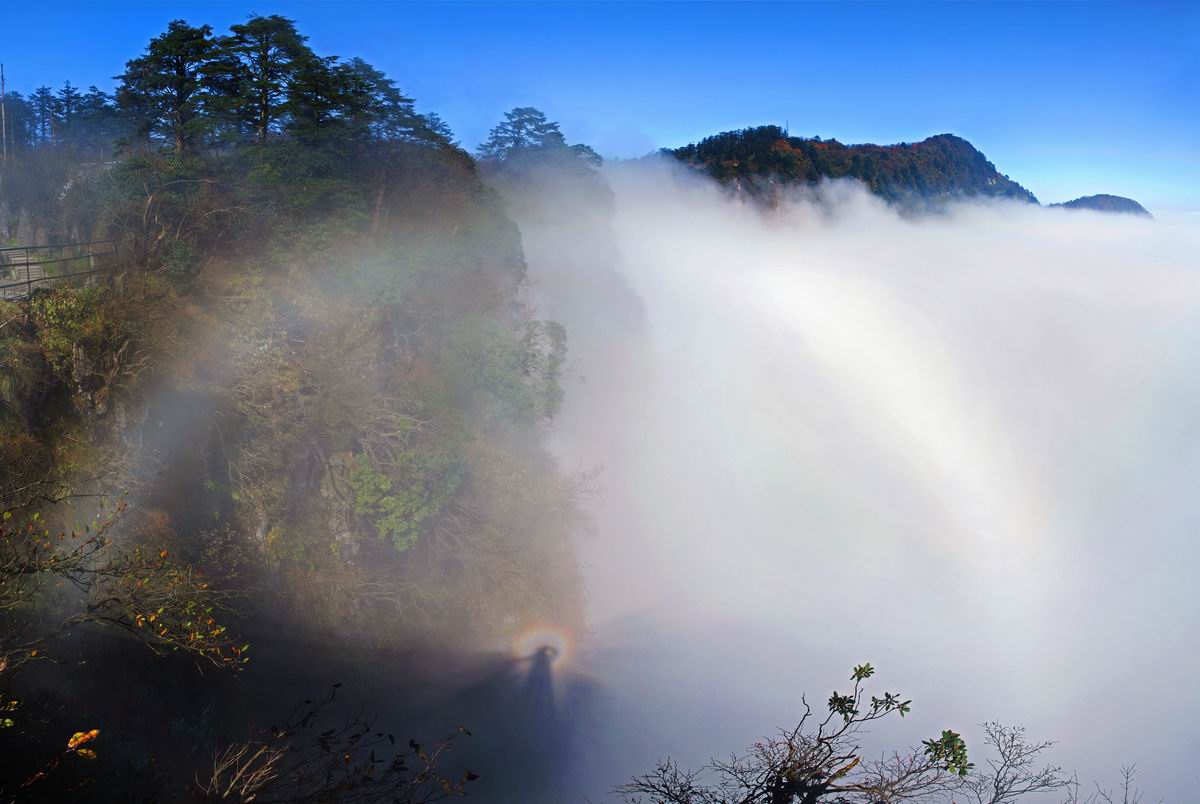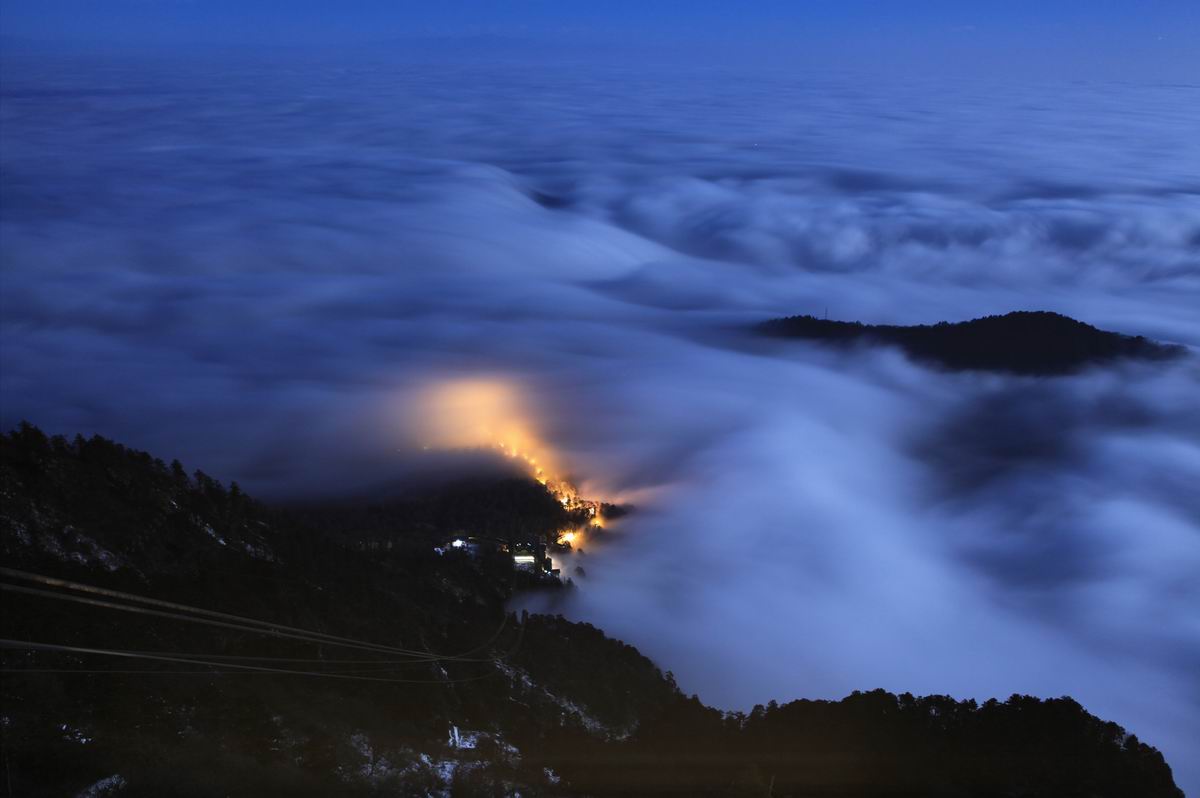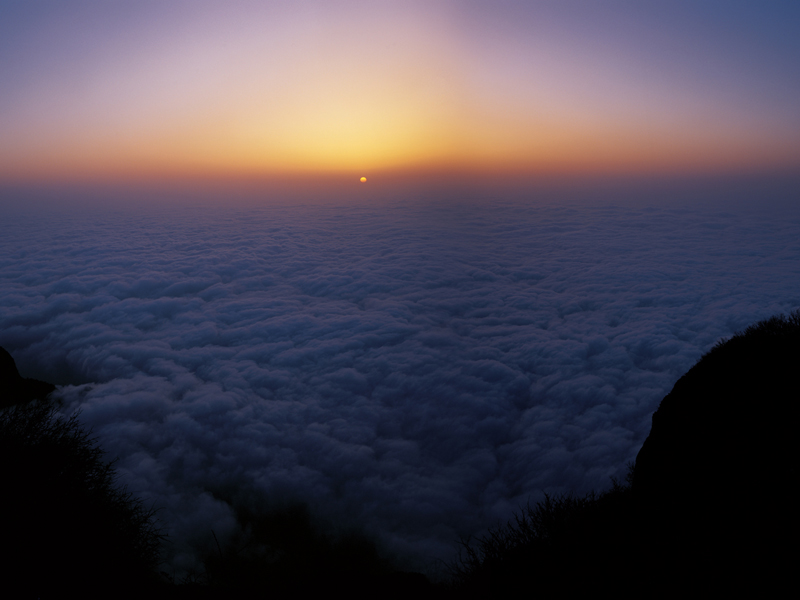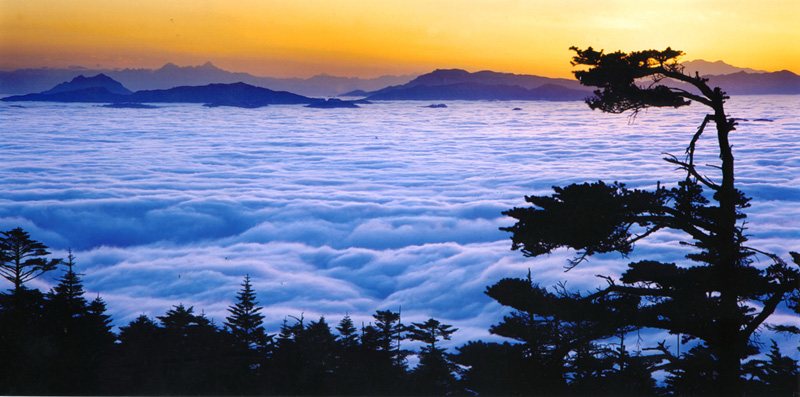Wonders
The Buddha’s Light: The Buddha’s Light is considered the appearance of Samantabhadra Bodhisattva in front of mortal people as a result of their good luck. Therefore, it is also called “Image of Light ” and “Light of Treasure”. It is said that only relatively well-enlightened monks can see the Buddha’s Light. However, as a matter of fact, everyone can see the Buddha’s Light under certain environmental conditions. The Buddha’s Light is an atmospheric optical phenomenon formed in specific environment. It is mostly formed in mountainous areas with an altitude of about 1,600 m. People may see The Buddha’s Light when mist disperses and the sunlight turns up. Standing in the same direction as the sunlight (back to the sun), and forming a 40-degree angle between the sun, the cloud and mist as well as the viewer himself, he may see the Buddha’s Light. The Buddha’s Light is generally a two-meter-diameter halo of seven colors including red, orange, yellow, green, cyan, blue and purple. At the center of the halo, it is illusorily bright like a mirror, and there is a human-body-shape shadow. Sometimes, the viewer may find his own image in the halo as if looking into a mirror, and every gesture is reflected. The viewer can only see his or her own image even if a crowd of people are watching it together. The Buddha’s Lightappears and blurs in the cloud with the movement of the sunlight. It is actually the refraction of the sunlight when the sun shines on the water vapor of the clouds. Therefore, clouds, mist and slanted sunlight are necessary conditions for it to appear.That is to say the appearance of the Buddha’s Light needs sunlight and a screen of cloud and mist. The Buddha’s Light cannot form if the mist is too dense or if there is no mist at all. Even if there is cloud and mist, but the altitude of the sun is too high, then, human image cannot be reflected on the screen of cloud and mist, thus, tourists rarely see the Buddha’s Light. According to its size, shape and tone, the Buddha’s Light has different names such as Water Light, Pratyeka-Buddha Light, Fairchild Light, Golden Bridge, Clear Appearance, Reverse Appearance, Large Appearance and Small Appearance. A person in Qing Dynasty named Ding Wencan wrote in his poetWatching the Buddha’s Light: "The cloud is in five colors and miraculous lights appear. It is in the shape of Buddha beads but it is never square. What is even more extraordinary is that everyone’s shadow is hidden inside.”Every year the Buddha’s Light appears about 40 to 70 times, averaging 3 to 5 times monthly in Mt. Emei, where it appears most frequently. Most of the times it appears after 9:00 a.m. or before 5 p.m. in sunny days after a rain.

Holy Lamp: In a dark moonless night at the Golden Summit, a spot of light may appear in the darkness under the Sheshen Cliff as if produced by a firefly. Then several more spots will appear, and gradually there will be countless spots of light. Sometimes, these light spots may be bright, and sometimes they may become dim. Sometimes they gather, and sometimes they become scattered and keep floating freely. Buddhists call it “Holy Lamp”, and explain it as “tens of thousands of bright lamps worship Samantabhadra”. There are three scientific explanations for the Holy Lamp: phosphorescent light, light from fireflies, and light produced by halimasch (kind of fungus) when it reacts with rainwater. Four natural conditions are necessary for the Holy Lamp to appear. The first one is that the sun shines again after the rain at the foot of the mountain. The second is a moonless sky. The third is no mist at the foot of the mountain. And the fourth is that there is no strong wind or heavy rain at the mountain top. Therefore, Holy Lamp is even rarer than the Buddha’s Light.

Sea of Clouds: The altitude difference of Mt. Emei is 2,500 meters, while the cloud layer usually forms between the altitudes of 1,000 meters to 2,000 meters. Therefore, it can be seen all year round above Xixiang Pool. At the Golden Summit, clouds are under the feet. Below Xianfeng Temple, clouds are above the head. At Huayan Summit, people are in the clouds. In the winter half of the year, airflow is stable and heat convection is not strong, so clouds are relatively stable and the cloud surface is smooth. As a result, only mountain peaks stick out of the cloud surface, which look like isolated islands. In the summer half of the year, vertically upward airflow is very strong, so cloud waves move up and down like blooming white flowers. Floating clouds are like surging sea waves sweeping the entire earth, moving forward with great momentum and in vast scale. In a clear blue sky, white clouds rise from countless valleys. In a moment a vast and hazy sea of clouds extends to the horizon like a snow-white flannelette blanket. It is bright, clean, thick, sleek and boundless. It looks as if it is resting or sleeping. Sometimes, a layer of clouds is over the ground and another is in the sky. When people stand between these two layers of clouds, they will have the feeling that they are walking on clouds as immortals.Fan Chengda, a Southern Song Dynasty poet, called the sea of clouds “the world of Douluo Fabric”, and Buddhists call it “the Silver World”.

Sunrise: The sky before dawn is beautiful in the Golden Summit. In the east, the sky is blackish green, the same color as the ground. Gradually, a ray of red glow of the sun is uprising, with a couple of colorful clouds edged with golden color, indicating a glorious daytime is coming. Under the colorful clouds, a glimpse of purplish red is going up gradually, and turning to a small arc, semi-circle, turning tangerine and red; later, jumping out. In fine days, the sun rises from the horizon, and you can watch the sunrise process; sometimes, when the sun rises with clouds around, what you can see is the red sun; and in cloudy days, you can only see the morning glow and sea of clouds sometimes.


